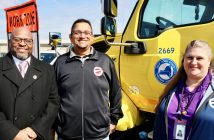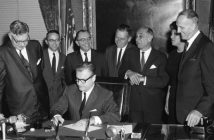 When severe winter weather makes our roads treacherous, CSEA members head into the storm to keep New Yorkers safe.
When severe winter weather makes our roads treacherous, CSEA members head into the storm to keep New Yorkers safe.
Our members whose job duties include keeping the roads clear are providing a valuable public service in keeping roads safe for emergency vehicles, emergency service workers, people who provide essential public services and traveling community members.
For workers responding to winter storms, including state, county and municipal highway workers, this often means countless hours of road preparation and snow and ice removal to ensure we can get back to normal as quickly as possible.
To build public awareness and improve safety, CSEA is working again this year to urge drivers to slow down and be patient around snowplows and related vehicles so that we can safely do our jobs and keep you safe.
Winter plow safety and driving quick tips!
- Yield to snowplows. They travel slower than posted speeds.
- Give snowplow drivers plenty of room to do their jobs. The safest place for you is far behind a snowplow.
- Never drive into a spray of snow generated by a snowplow.
- Slow down! Never use cruise control on wet or icy roads.
- Stay alert. A snowplow weighs 17 times more than a car. In a crash, occupants of a car are much more likely to be seriously injured.
- Be patient. Follow well behind a snowplow.
- NEVER pass between tandem plows.
- Do not drive beside snowplows.
- Check your vehicle. Before you drive, check your tires for adequate tread and inflation, check your windshield wipers and windshield washer fluid.
- While four-wheel drive (4WD) helps you get moving and keep moving during the storm, it does not help you stop.
Clearing the way for winter travel
Listen for approaching snowplows while shoveling your driveway or sidewalk. Move yourself, children and pets away from the street, snowbanks and cul-de-sacs. It could mean the difference between winter fun and a preventable tragedy.
A truck’s wings and plows can span more than 18 feet. As snow falls, 20-foot wide streets get narrower as banks build, pushing us further into the lane. Give snowplows room to work. Put extra space between you and the plow
to ensure that snowplow drivers can see you.
If you don’t need to be on the roads in a storm, stay home. If you do need to travel, remember that emergency crews’ response times are dependent on roads that are cleared. Remember, plows travel slower and can stop suddenly — don’t speed, don’t crowd and don’t pass.
 Distracted and drowsy driving also a risk to snowplow operators
Distracted and drowsy driving also a risk to snowplow operators
Worsening aggressive, distracted and drowsy driving amplifies the risk that snowplow operators face when they head out in treacherous conditions to clear roads. As always while driving, don’t talk or text on your mobile phone. Be fully alert during winter weather — ice and snow are difficult enough to handle without added distractions.
Plow zones are work zones
- There is a work zone fatality every 10 hours or 2.3 fatalities per day.*
- Additionally, there is a work zone injury every 13 minutes or 110 per day.*
- 45 CSEA members have been killed working on New York’s roads since 1983.
*Source: U.S. Department of Transportation’s Federal Highway Administration.
 Watch for tow plows!
Watch for tow plows!
Tow plows are becoming more common in New York. The tow plow assembly swings out to plow the lane next to the rig. According to the state Department of Transportation, any snowplow creates a ridge of snow to its side that can cause you to lose control of your vehicle. The plow kicks up a snow cloud that causes total whiteout conditions. You may not be able to see the tow, which can be dangerous for you and plow operators. Because tow plows are much larger than normal snowplows, it is especially important to use extra caution.
Help curb distracted driving
The U.S. Department of Transportation’s National Highway Safety Administration (NHTSA) recently released proposed guidelines to help address driver distraction caused by mobile or electronic devices. The proposed guidelines are aimed at portable and aftermarket device developers to include safe driver modes and reducing driver distraction by design.
The agency is seeking public comment on its proposed guidelines. Submit comments at tinyurl.com/nhtsa-guidelines.
Watch our members in action
A series of 2015 videos show our Town of North Hempstead Unit members responding before, during and after a severe winter storm. Watch the videos below.
Spread the word
Help us raise awareness and encourage action by spreading the word to all drivers, including new drivers. Share stories about plow safety on social media, and help drivers to Don’t Zone Out!
Like us: facebook.com/dontzoneout
— Jill Asencio





